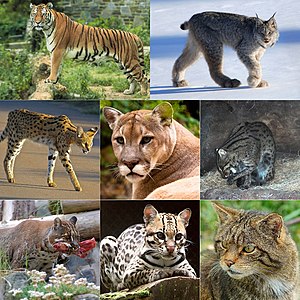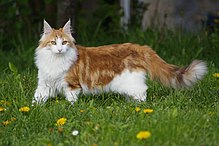Portal:Cats
The Cats PortalFelidae (/ˈfɛlɪdiː/) is the family of mammals in the order Carnivora colloquially referred to as cats. A member of this family is also called a felid (/ˈfiːlɪd/). The term "cat" refers both to felids in general and specifically to the domestic cat (Felis catus). The 41 extant Felidae species exhibit the greatest diversity in fur patterns of all terrestrial carnivores. Cats have retractile claws, slender muscular bodies and strong flexible forelimbs. Their teeth and facial muscles allow for a powerful bite. They are all obligate carnivores, and most are solitary predators ambushing or stalking their prey. Wild cats occur in Africa, Europe, Asia and the Americas. Some wild cat species are adapted to forest and savanna habitats, some to arid environments, and a few also to wetlands and mountainous terrain. Their activity patterns range from nocturnal and crepuscular to diurnal, depending on their preferred prey species. (Full article...) Selected species -The Chinese mountain cat (Felis bieti), also known as Chinese desert cat and Chinese steppe cat, is a small wild Felis species with sand-coloured fur, faint dark stripes on the face and legs and black tipped ears. It is endemic to the Tibetan Plateau of western China, where it lives in grassland above elevations of 2,500 m (8,200 ft). It has been listed as vulnerable on the IUCN Red List since 2002. (Full article...) List articles
Related portalsWikiProjectsSelected breed -The Norwegian Forest cat (Norwegian: Norsk skogkatt and Norsk skaukatt) is a breed of domestic cat originating in Northern Europe. This landrace breed is adapted to a very cold climate, with a top coat of long, glossy hair and a woolly undercoat for insulation. The breed's ancestors may have been a landrace breed of short-haired cats brought to Norway about A.D. 1000 by the Vikings, who may also have brought with them long-haired cats, like those ancestral to the modern Siberian and Turkish Angora. During World War II, the Norwegian Forest cat was nearly extinct; then the Norwegian Forest Cat Club's breeding program increased the cat's number. It was registered as a breed with the European Fédération Internationale Féline in the 1970s, when a cat fancier, Carl-Fredrik Nordane, took notice of the breed and made efforts to register it. The breed is very popular in Norway, Denmark, Sweden, Iceland, and France. (Full article...) Did you know... -
TopicsAssociated WikimediaThe following Wikimedia Foundation sister projects provide more on this subject:
Discover Wikipedia using portals |

























